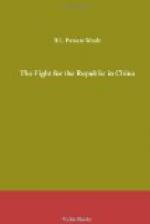Group I, which deals with the fruits of victory in Shantung, has little to detain us since events which have just unrolled there have already told the story of those demands. In Shantung we have a simple and easily-understood repeated performance of the history of 1905 and the settlement of the Russo-Japanese War. Placed at the very head of the list of demands, though its legitimate position should be after Manchuria, obviously the purpose of Group I is conspicuously to call attention to the fact that Japan had been at war with Germany, and is still at war with her. This flourish of trumpets, after the battle is over, however, scarcely serves to disguise that the fate of Shantung, following so hard on the heels of the Russian debacle in Manchuria, is the great moral which Western peoples are called upon to note. Japan, determined as she has repeatedly announced to preserve the peace of the Orient by any means she deems necessary, has found the one and only formula that is satisfactory—that of methodically annexing everything worth fighting about.
So far so good. The insertion of a special preamble to Group II, which covers not only South Manchuria but Eastern Inner Mongolia as well, is an ingenious piece of work since it shows that the hot mood of conquest suitable for Shantung must be exchanged for a certain judicial detachment. The preamble undoubtedly betrays the guiding hand of Viscount Kato, the then astute Minister of Foreign Affairs, who saturated in the great series of international undertakings made by Japan since the first Anglo-Japanese Treaty of 1902, clearly believes that the stately Elizabethan manner which still characterizes British official phrasing is an admirable method to be here employed. The preamble is quite English; it is so English that one is almost lulled into believing that one’s previous reasoning has been at fault and that Japan is only demanding what she is entitled to. Yet study Group II closely and subtleties gradually emerge. By boldly and categorically placing Eastern Inner




